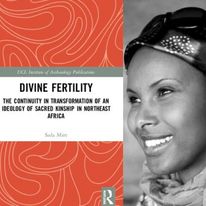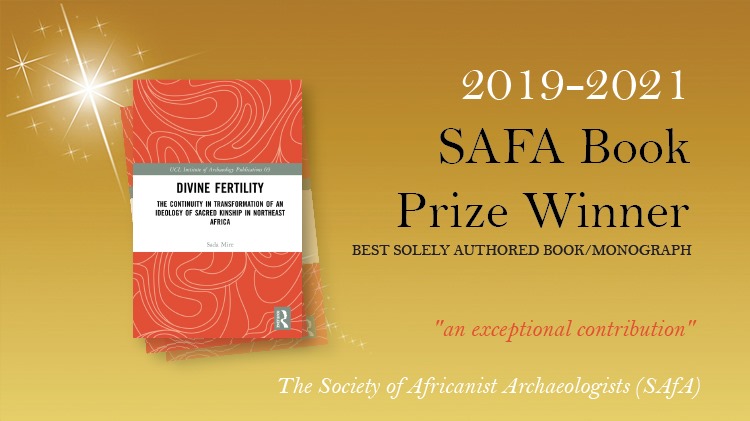Dr Sada Mire became the first African Scholar To win SAFA Book Prize for Her Book Divine Fertility “This s book uniquely explores the impact of indigenous ideology and thought on everyday life in Northeast Africa.
Furthermore, in highlighting the diversity in pre-Christian, pre-Islamic regional beliefs and practices that extend beyond the simplistic political arguments of the current dominant narratives, the study shows that for millennia complex indigenous institutions have bound people together beyond the labels of Christianity and Islam; they have sustained peace through cultural exchange and tolerance (if not always complete acceptance).
Through recent archaeological and ethnographic research, the concepts, landscapes, materials and rituals believed to be associated with the indigenous and shared culture of the Sky-God belief are examined. The author makes sense, for the first time, of the relationship between the notion of sacred fertility and a number of regional archaeological features and on-going ancient practices including FGM, spirit possessions, and other physically invasive practices and the ritual hunt.
The book explores one of the most important pilgrimage centres in Somaliland and Somalia, the sacred landscape of Saint Aw-Barkhadle, founded ca. 12th century AD. It is believed to be the burial place of the rulers of the first Muslim Ifat and Awdal dynasties in this region, and potentially the lost first capital of Awdal kingdom before Harar.
This ritual centre is seen as a ‘microcosm’ of the ancient Horn of Africa with its exceptional multi-religious heritage, through which the author lays out a locally appropriate archaeological interpretational framework, the “Ritual Set,” also applied here to the Ethiopian sites of Tiya, Sheikh Hussein Bale, Aksum and Lalibela, setting these places against a wider historical background of indigenous Sky-God belief.
This archaeological study of sacred landscapes, stelae traditions, ancient Christian and medieval Muslim centres of Northeast Africa is the first to put forward a theoretical and analytical framework for the interpretation of the shared regional heritage and the indigenous archaeology of the region. It will be invaluable to archaeologists, anthropologists, historians and policymakers interested in Africa and beyond.
Reviews:
“An exceptional contribution” – Society of Africanist Archaeologists “
“This is a confident, masterly piece of work by somebody uniquely qualified to carry out the relevant research… a remarkable and vivid book, which probably only Sada Mire (with her combination of theoretical proficiency in several academic disciplines and local intimacy) could have achieved. This is scholarly work, with a much wider general appeal”. -Neal Ascherson, author of The King Incorporated and formerly journalist at The Observer.
Sada Mire grew up in the Horn of Africa and senses a continuity in sacred landscapes that cuts across space and time and the boundaries of states and religions.
Her book provides a brave and bold conception of the regional system based on an almost forensic analysis of the evidence. Mire shows how the inclusion of material culture as evidence is central to understanding how continuities are created over time, but also how history can be masked at the same time as it is revealed. The argument is engrossing; chapter by chapter she builds up a convincing and absorbing argument for a discursive regional trajectory centred on the beauty and power of place curated over time by different faiths.
The book illustrates the importance of location for symbolic action, knowledge and cultural memory, and the centrality of place as an entry point to understanding the deep past through an ongoing present. Underlying the history of the region is a syncretic trajectory, a multi-temporality, that is often challenged by fundamentalist positions but with an underlying structure that is centred on kinship deeply connected to a sacred landscape. As she concludes: ‘From out of the womb of ancient indigenous and regional religions there has arisen a set of ideas reflected in practices, features and objects, all of which seem to connect the north and the west of the Horn of Africa with the south and the east.’
“The book is an exceptional study of cultural memory in place; a rich encounter with the deep history of symbolic action, emotion and aesthetic affect.” -Professor Howard Morphy, Australia National University
“Dr. Sada Mire has done much to publicize the archaeology and heritage of the Horn of Africa, particularly Somaliland, and is an inspiration to a new generation of scholars, both inside Africa and elsewhere.” – Professor Timothy Insoll, African Archaeology Review
“This fieldwork and commitment to the past of an archaeologically neglected region already makes Sada a pioneer” – Dr Stephanie Wynne-Jones, Trowelblazers and University of York
“Dr Mire has provided a genuinely post-colonial approach” -Professor Paul Lane, University of Cambridge.
About the Author
Sada Mire is an award-winning Swedish-Somali archaeologist with a PhD from UCL’s Institute of Archaeology. She is founder and executive director of Horn Heritage Organisation, an archaeology and heritage research institution with offices in the Horn of Africa and The Netherlands.
Mire was the founding director of Somaliland’s Department of Archaeology until 2012 and since then has held academic positions at a several European universities including Leiden University. She has received a number of honours for her work, including being selected for lists such as New Scientist’s “Most Inspiring Women in Science of All Times” in 2016 and The Hay Festival of Literature and Arts’ list of 30 Global Thinkers and Writers.
Mire’s popular contributions, as well as commissioned features on her work, appear regularly in the international media, such as the BBC, The Guardian, CNN and Channel Four, UK. At the moment, she is working on a book on Somali Heritage and Identity Conflicts.





























